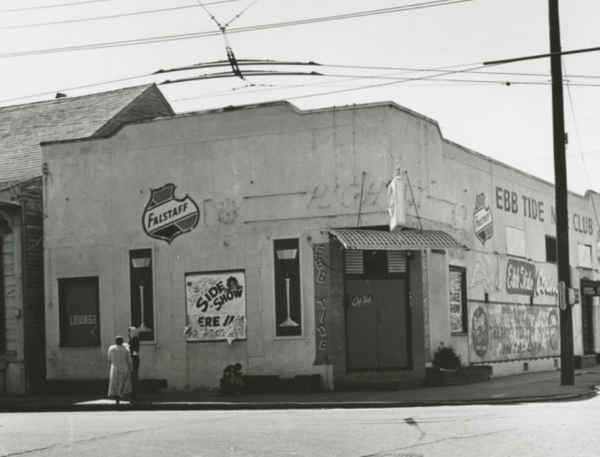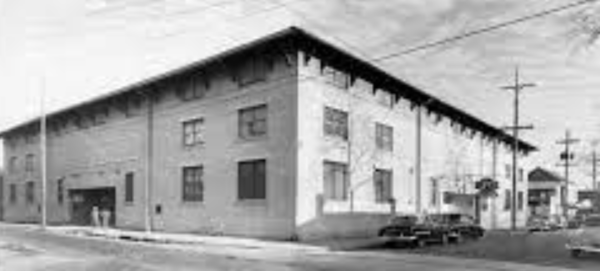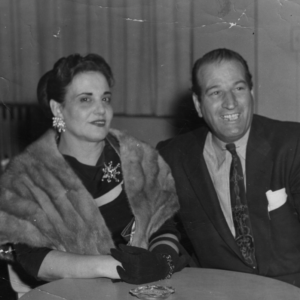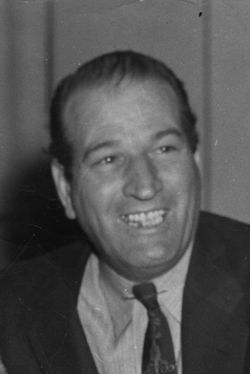Louis Messina, Sr.: Promoter & Club Owner
By August 1942, Louis Messina (1910-1986) was actively promoting music and events at two businesses, the Gypsy Tea Room and the Victory Arena, where he had begun promoting Black boxing matches in July. He brought Louis Armstrong to the Victory (originally known as the Coliseum Arena) and the GTR on August 9, 1942 in a pattern repeated often over the remaining years of World War II: a big concert / show & dance headlined by a traveling star attraction at the Arena/Coliseum, followed by a late-night party and celebration at the GTR. Armstrong was one of those stars when he returned the following year, with another street parade with bands marching to the Victory Arena show, “a Mardi Gras celebration,” all sponsored by Messina, “leading the south in prize-fight and dance” promotion.”
Timelines that bring Messina into control of these two enterprises are not completely clear. GTR was operating as a successful club when Eddie Burbridge visited in 1937 on his “jive tour of clubs,” reporting for the Louisiana Weekly that he stopped by “Johnny Tessitore’s Gypsy Tea Room for their last floor show” as well as Mike Tessitore’s Japanese Garden. At the GTR, he ran into Allen Page, another local sports and entertainment promoter who was also “big boss of the Black Pelicans.” The Weekly would write, in 1948, “Local baseball and boxing fans are fortunate in having two of America’s outstanding sports promoters in their midst. These two astute devotees of top-notch sports are Allen Page, the South’s premier impresario of diamond excellence, and Louis Messina, Dixie’s own version of the immortal Tex Rickard.” Regularly featured at the GTR were Alma Purnell, the Sepia Eleanor Powell (whom many said was a better dancer than Ginger Rogers) and Stove-pipe, the comedian, who was “a scream. “

The Gypsy Tea Room, “the South’s longest night spot,” courtesy of Hogan Jazz Archives, Tulane University
Messina is identified as “the genial proprietor” of the Gypsy Tea Room in December 1939, his name thereafter mentioned in the Louisiana Weekly increasingly as a music promoter and organizer. By early 1940, the Zulus were headquartered at the GTR, which soon after enlarged to include an open air dance pavilion. Its grand re-opening celebrated St. Joseph’s Day and Easter with a big show and dance featuring Don Raymond’s and Papa Celestin’s orchestras. Sometimes called “the South’s longest night spot,” GTR was re-modeled again in 1945, to accommodate 2,000 patrons. Musicians Local 496 often held its meetings there. For a while during World War II, Messina also operated a Gypsy Tea Room #2. In 1945, he was elected president of the Dixie Promoters Association in a meeting held at the GTR.
Messina’s first boxing promotion was a July 10, 1942 card at what had been the Coliseum Arena but had been re-branded as the Victory Arena earlier in 1942.. The Times-Picayune reported in July that Messina had recently been licensed by the Louisiana Athletic Commission to succeed Lou Ovalasiti as the arena’s boxing promoter. Harry Frisch, lease-holder, would be subleasing it to Messina for a series of Friday night fights for Blacks, with “one section set aside for Whites.” BoxRec.com contends that he took over promotion of African-American boxers in New Orleans from Heard Ragas, calling Messina “the most successful promoter in New Orleans during World War II.” By September 1943, it was once again the Coliseum Arena, often just “the Coliseum.”
Messina lost his one boxing match, as a featherweight, knocked out by John King at 1:32 in the 2nd round on May 8, 1928, in Madison Square Garden, in the second round of the AAU state Championships, which seems to indicate he was a New York native. How he subsequently got to New Orleans as a club owner is not clear.
The Louis Armstrong show in August 1942 appears to have been Messina’s first big music promotion. He subsequently moved to blend his GTR shows with Sunday night promotions featuring the best Black entertainers in the U.S., usually with a local act like Sidney Desvigne’s orchestra or, by 1944, the Dooky Chase orchestra as opener. In addition to Armstrong, locals could see any of these acts for about a dollar at the Coliseum: Lucky Millender, Ella Fitzgerald, Jay McShann, Cootie Williams, Hot Lips Page, Jimmy Lunceford, Tiny Bradshaw, Fatha Hines, Billy Eckstine, Dizzy Gillespie, Louis Jordan, and Billie Holiday. Some came back again and again. Tickets for the Armstrong show on August 9, 1942, with dancing from 8 p.m. – 2 a.m., were 90 cents, advanced; $1.10 at the door; .55 for the balcony but for future Messina-promoted shows, they were generally $1.25 advance, $1.50 at the door, and $1 for servicemen and balcony seats.

The Coliseum Arena, built in 1922. Its balcony occupied a 4th floor that’s barely visible in its faded roofline. Courtesy of Hogan Jazz Archives, Tulane University
When the Coliseum Arena was built in 1922, it was billed as “one of the finest and most compact indoor auditoriums in the South,” with a seating capacity of 8,000. Its boxing matches were a highlight for visitors to New Orleans, according to the 1938 WPA New Orleans Guide. By the time Messina took it over, it was in need of repair, and locals were loudly complaining about the quality of boxing that it was hosting.
Messina seems always to have been an expert at promotions, and he knew the value of publicity in Black audience newspapers like few other White promoters of his time. The Chicago Defender began covering New Orleans’ Black boxing scene regularly, reporting that Messina “is noted for his fair dealing with Negroes in the past” and “promises to bring the best talent in America to the Victory Arena.” The crowds for Friday night fights at the Victory increased because of the quality of fights, their high visibility, and Messina’s skills at promotion. He often admitted Black servicemen free and also began promoting boxing at Pelican Stadium, in December 1942 putting on the first outdoor boxing match in the city in 8 years.
Big shows had come to the Coliseum as well as local clubs prior to World War II but without a promoter’s name regularly associated with them. When Armstrong performed in 1940 and 1941, promotion focused on the venue–the Rhythm Club–and not a named promoter. During the late 1930s, the Rhythm Club and Tick Tock brought in a few national acts–Ella Fitzgerald and Walter Barnes, for example–but the live music scene was dominated by orchestras and bands led by locals such as Desvigne, Papa Celestin, Don Raymond, Paul Barbarin, Fats Pichon and Joe Robichaux.
At least a couple of local White boxing promoters also had booked Black boxing bouts at the Coliseum before Messina took over that business in July 1942. In Messina’s first boxing promotion, Kid Percy defeated Johnny Monroe in an 8 round decision and Holman Williams knocked out Randy Brown in the 5th round. The card also featured two 3-round preliminary bouts and what would prove to be a staple of Messina promoted-boxing matches, a comic fight, this one featuring Kid Okra. These novelty comic bouts usually resulted in draws between such characters as Kid Hambone and the Praline Kid, Memphis Lewis and Lolly Pop Jones, Midget Jones and Ringer the Kid. For that first fight, Messina reported 2,000 paid attendance with a $1,092.45 gate. An August 1942 fight card reported a 400% increase in gate, to $4,195.98, and, for the feature fight, a Charley Burley upset of Holman Williams in the 9th.
Early in 1943, Messina traveled to St. Louis by airplane to sign a big bout, outbid two major Chicago promoters for another, and flew to New York to scout for a future card. At least twice he successfully got boxers suspended for failing to appear at bouts he had scheduled in New Orleans. He also worked with Allen Page to coordinate schedules of fights, baseball games, and music events. His outdoor promotions at Pelican Stadium attracted over 5,000 fans. Messina was clearly a man who appreciated local talent, which he promoted as aggressively as he did the traveling stars. He booked Sidney Desvigne’s orchestra as a regular feature on virtually every Saturday and Sunday night at GTR from 1943-45, often engaged in a battle of the bands with one of the touring acts as a feature. And he was also an early promoter of young Dooky Chase and his band, booking them at the Coliseum in frequent battles of the bands and for jitterbug competitions there and at GTR.
He was not, however, an absentee White owner. GTR hosted integrated bands comprised of locals, and his presence in the Black community is noted by Louisiana Weekly reporters at the GTR and Coliseum, and at a John Hammond-produced show and dance at Camp Plauche in 1944.

Lou & Mary Ann Messina
He remained active in New Orleans music and sports promotions for most of the 1950s. He married Marian Louise LoBuono in 1938 in New Orleans, and they had three children. Messina is a member of the American-Italian Sports Hall of Fame in New Orleans. He was 75 when he died January 6, 1986.
Louis Messina, Jr. lives in Houston and is a leading music producer, counting George Strait, Kenny Chesney, Eric Church, Blake Shelton and Little Big Town among his clients. He grew up “on the streets of New Orleans” where he credits seeing an Elvis concert at age 7 with setting him on a path of music management. Presley played two shows at Municipal Auditorium on August 12, 1956. Admission started at $1.05; his dad was not the promoter of record.
Partial list of concerts & events promoted by Louis Messina in New Orleans, 1942-45.
Based on reports in the Times-Picayune, the New Orleans Weekly, and boxing.rec. Too bad there’s not a musical entertainments data base as thorough as box.rec’s.
1942
July 10 boxing at Victory Arena
Times-Picayune reports on Louis Messina’s first offering as a promoter of weekly Negro Friday night fights at the Victory Arena, Kid Percy decisions Johnny Monroe, 8 rounds. Both were New Orleans natives though Percy was living in Baton Rouge at the time. Holman Williams KOs Randy Brown, 5th round. George Lewis KOs Lambert Ross. Both were from New Oerleans, Lewis making his pro debut. Ed Smith KOs Eddie Smith, 3rd round. Both were from New Orlean and making their debuts. Ed Smith lost his only other fight, and this was Eddie Smith’s only fight.
July 24 boxing, Victory Arena: Holman Williams decisions Lorenzo Strickland.
July 31 boxing at Victory Arena: Kid Percy decisions Howell King in 12 rounds. “Amusing antics” of Kid Harry, a dwarf, and the Praline Kid are noted by the Chicago Defender.
Aug. 9 Louis Armstrong, Victory Arena & GTR.
Aug. 14 boxing, Victory Arena: Charley Burley upsets Holman Williams 9th round.
Sept. 11 boxing, Victory Arena: All Negro servicemen admitted free.
Sept. 25 boxing, Victory Arena: Kid Percy defeats Eugene Brown.
Oct. 16 boxing, Municipal Auditorium: Kid Percy defeats Panther Red.
Dec. 12 boxing, Coliseum Arena: Holman Williams decisions R.J. Lewis, 12 rounds.
Dec. 13 boxing, Pelican Stadium: Kid Cocoa KOs Young Peter Jackson, all-star card of preliminary fights.
1943
Jan. 15 boxing, Victory Arena: Cocoa Kid decisions Holman Williams, 12 rounds. 4 fights on undercard.
Jan. 24, 1943 boxing, Victory Arena: Henry Hall KOs P.G. Carson, 6th round.
Feb. 14 Brown Skin Models, GTR.
Feb. 19 boxing Victory Arena: Holman Williams decisions Roosevelt, 10 rounds.
Feb. 28 International Sweethearts of Rhythm, GTR.
Mar. 12 boxing at Victory Arena: Al Reasoner decisions Willie Roach, 10 rounds. Sgt. Anthony Jones KOs Deacon Johnny Brown, 7th round.
Mar. 26 boxing at Victory Arena: Holman Williams vs. Sgt. Anthony Jones, former Southern Illinois Golden Gloves champ.
Mar. 21 Andy Kirk & Clouds of Joy, GTR.
Mar. 26 boxing at Victory Arena: Holman Williams decisions Sgt. Anthony Jones, 10 rounds.
Apr. 2 boxing at Victory Arena (last fight there before returning to Coliseum Arena designation): Al Gomez vs. Larry Amadee. Al Reasoner decisions Alvin “Bevil” Gomez, 12 rounds.
Apr. 19 boxing at Pelican Stadium: Louis “Kid” Cocoa vs. Charley Burley, “the giant killer,” in a re-match of fight won by Burley. Seating for 10,000: “first colored boxing” at Pelican in five years. 2 preliminaries, starts at 8:30, main event at 10:00 p.m. First 5,000 servicemen free–tickets at the USO Center
May 22 Christine Chatman, GTR, “the South’s longest night spot.”
July 4 boxing, Pelican Stadium: Montgomery KOs Al Reasoner, 6th round; Sgt. Anthony Jones KOs Singapore Kid. 5,000 in attendance.
Aug. 1 boxing, Pelican Stadium: Al Reasoner decisions Georgia Pace, 10 rounds.
Aug. 22 Louis Armstrong, Coliseum Arena
With a street parade, bands, and civilians marching , “a Mardi Gras celebration,” with bars and restaurants throughout the city featuring Armstrong tunes on their music boxes, all sponsored by Messina.
Sept. 3 boxing, Coliseum Arena: Holman Williams decisions Lloyd Marshall, 10 rounds.
Sept. 17 boxing, Coliseum Arena: Al Reasoner decisions Cleo Shans, 10 rounds.
Sept. 24 boxing, Coliseum Arena.
Oct. 15 boxing, Coliseum Arena: Al Reasoner, Cleo Shans fight to a draw.
Oct. 22 boxing, Coliseum Arena.
Oct. 29 boxing, Coliseum Arena.
Nov. 5, boxing, Coliseum Arena.
Nov. 19 boxing, Coliseum Arena: Chalky Wright KOs Al Reasoner, 1st round.
Dec. 3 boxing, Coliseum Arena: Anthony Jones KOs P.G. Carson in 8th round.
Dec. 5 Carolina Cotton Pickers v. Sidney Desvigne’s Orchestra, who ”played music all over” the Pickers, GTR.
Dec. 10 boxing, Coliseum Arena: Henry Hall decisions P.G. Carson, 10 rounds.
Dec. 19 Joe Louis stops by the GTR.
Dec 19 Boxing, Coliseum Arena Henry Hall decisions P. G. Carson, 10 rounds.
Tommy Jones scheduled to fight Sgt. Mad Anthony Jones in a benefit to support the Good Citizens’ Insurance Company People’s Defense League and the Colored Doll and Toy Fund. Jones doesn’t show up. Original contract fronted Jones $137 and guaranteed him 20% of the gate; he later demanded a $500 guarantee. The Chicago Defender reports: “Two Chicago Boys, Bill Parsons and Tommy James cane to Messina’s rescue” and funded the benefit. Jones was subsequently suspended.
1944
Feb. 7 Lucky Millender, Judy Carol, Trevor Bacon, and Sidney Desvigne Orchestra, Coliseum.
Mar. 5 Jay McShann orchestra, GTR.
Mar. 19 Gobs of Rhythm, “mixed orc” [Algiers Navy bandsmen and local whites], GTR.
Apr. 1 Sidney Desvigne’s Orchestra begins Sat. – Sun. night engagements at GTR.
Apr. 23 King Kolax, GTR.
May 12 boxing at Coliseum Arena: Freddie Dawson KOs Charlie Parham, 9th round. 3 fights on undercard.
May 14 Buddy Johnson, GTR.
May 28 Ella Fitzgerald, Ink Spots, Cootie Williams’ orchestra, GTR.
June 18 Gobs of Rhythm vs Sidney Desvigne’s Orchestra.
July 21 boxing, Coliseum Arena: Holman Williams decisions Anthony Jones, 10 rounds.
Sept. 15 boxing, Coliseum Arena: Holman Williams & Cocoa Kid, 12 round draw
Oct. 23 boxing, Coliseum Arena: Bernard Docuusen KOs Eddie Lee in 3rd round. 6 fights on undercard.
Nov. 6 boxing, Coliseum Arena: Bernard Docusen and Tommmy Rotolo draw, 6 rounds. 6 fights on undercard.
Nov. 12 Cootie Williams & Eddie Vinson, Coliseum.
Dec. 2 Desvigne’s Orchestra vs Darlings of Rhythm, GTR.
Dec. 3 Jay McShann & his Confessions Blues Orchestra, featuring Walter Brown, & Desvigne’s orch. Coliseum.
Dec. 22 boxing, Coliseum Arena: Holman Williams and Joe Carter draw, 10 rounds.
Dec. 24 Buddy Johnson vs Desvigne’s Orchestra, GTR.
Dec. 31/ Jan. 1 Sonny Boy Williamson & Orchestra, Coliseum.
1945
Feb. 4 Gobs of Rhythm vs Desvigne’s Orchestra, GTR.
Feb. 17 Nat Towles & Don Raymond Orchestra, at Coliseum for Beaticians Ball.
Mar. 3 Desvigne’s Orchestra every Sat. & Sun. GTR.
Mar. 4 Desvigne’s Orchestra vs Hot Lips Page orch, GTR.
Mar. 11 GTR #2 open; at GTR #1 Desvigne’s Orchestra continues every Sat. & Sun. night.
Apr. 1 Fletcher Henderson Orchestra with Dooky Chase’, the “newest swing sensation.”
Apr. 8 Nat Towles, GTR.
Apr. 15 Tiny Bradshaw & His Jersey Bounce Orchestra, with Dooky Chase band and jitterbug contest
Apr. 22 Tiny Bradshaw Orch & Dooky Chase band, GTR
Apr. 28 Desvigne’s orch vs. Gobs of Rhythm, GTR.
Apr. 29 Tab Smith & Trevor Bacon, Coliseum.
Dooky Chase band vs. Gobs of Rhythm, GTR.
May 6 Jimmy Lunceford Orcestra and Dooky Chase band, Coliseum.
May 20 boxing, Pelican Stadium.
Holman Williams decisions Joe Carter, 15 rounds.
June 3 Fatha Hines and Dooky Chase band.
June 17 Dooky Chase & his trumpet & his Rhythm Playboys vs. Ernie Fields, his trombone, and his 18-piece band, Coliseum.
Jun 24 Snookum Russell, GTR.
July 8 Louis Armstrong and Dooky Chase band at Coliseum for Swing Club’s bathing beauty contest.
July 22 Billy Eckstine and band, Dooky Chase and band, Coliseum.
Luis Russell and Desvigne’s Orchestra GTR.
Aug. 5 Dizzy Gillespie with Dooky Chase, the Nicholas Bros., Coliseum.
Aug. 17 boxing, Coliseum Arena featuring Holman Williams.
Sept. 8-9 Louis Jordan & Caldonia, GTR.
Sept. 16 Lucky Millinder & Rosetta Tharp, GTR.
Sept. 28 Billie Holiday & Joe Guy’s band.
Oct. 7 Joe Liggins & his Honeydrippers, GTR.
Oct. 14 Stepin Fetchit with Frank Humphries & his band, GTR.
Oct. 21 Hot Lips Page & Orchestra, GTR.
Oct. 28 Bon Bon & his Orchestra.
Dec. 30 Desvigne’s Orchestra v. Dooky Chase band, GTR.
Dates are derived primarily from the Louisiana Weekly and the Chicago Defender; actual performances that match the dates advertised have been verified when possible, but I suspect that not all cancellations are reported and many shows are not reviewed or even briefly noted. Many notices in the Weekly are clearly paid advertisements published in the form of news articles.
Sources:
“Lou Messina.” Promoters. BoxRec.com. Web. 17 Aug. 2022.
“Louis Charles ‘Leapin’ Lou’ Messina, Sr.” findagrave.com. 28 Aug. 2022.
“Randy Brown and Williams Meet Tonight.” New Orleans Times-Picayune. 1942 July 10: 16.
Also a survey of Louisiana Weekly issues 1939-1945; a search of Chicago Defender, 1930-1945; and select issues of the New Orleans Item and Time-Picayune, 1939-1945, mainly trying to verify Weekly and box.rec reports..
The importance of Messina in New Orleans music history seems somewhat neglected. His career also further connects the promotion and consumption of music and boxing as the predominant entertainments for Black New Orleanians. His use of “battles of the band” themed nightclub events, the comic bouts on his boxing match undercards, and the prevalence of boxers named Kid in a city where so many musicians also have that name were (and remain) intriguing. It seems likely that Missina’s boxing events included live music–most of Page’s baseball promotions did–especially given the interplay among boxers and musicians as facilitated by Messina. As late as 1940, local press was proclaiming it virtually impossible to successfully promote Black boxing in New Orleans; several promoters tried before Messina, and bouts were also staged in at least one club in the 1930s. He proved them wrong and became in the process one of the most important and influential figures in New Orleans.
September 18, 2024
